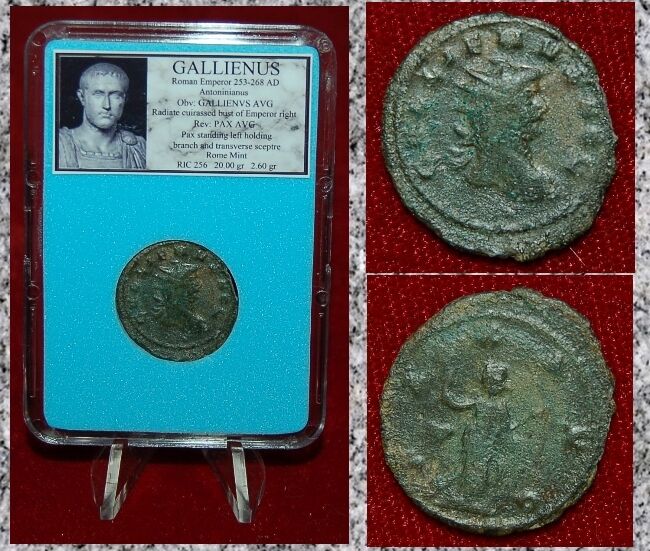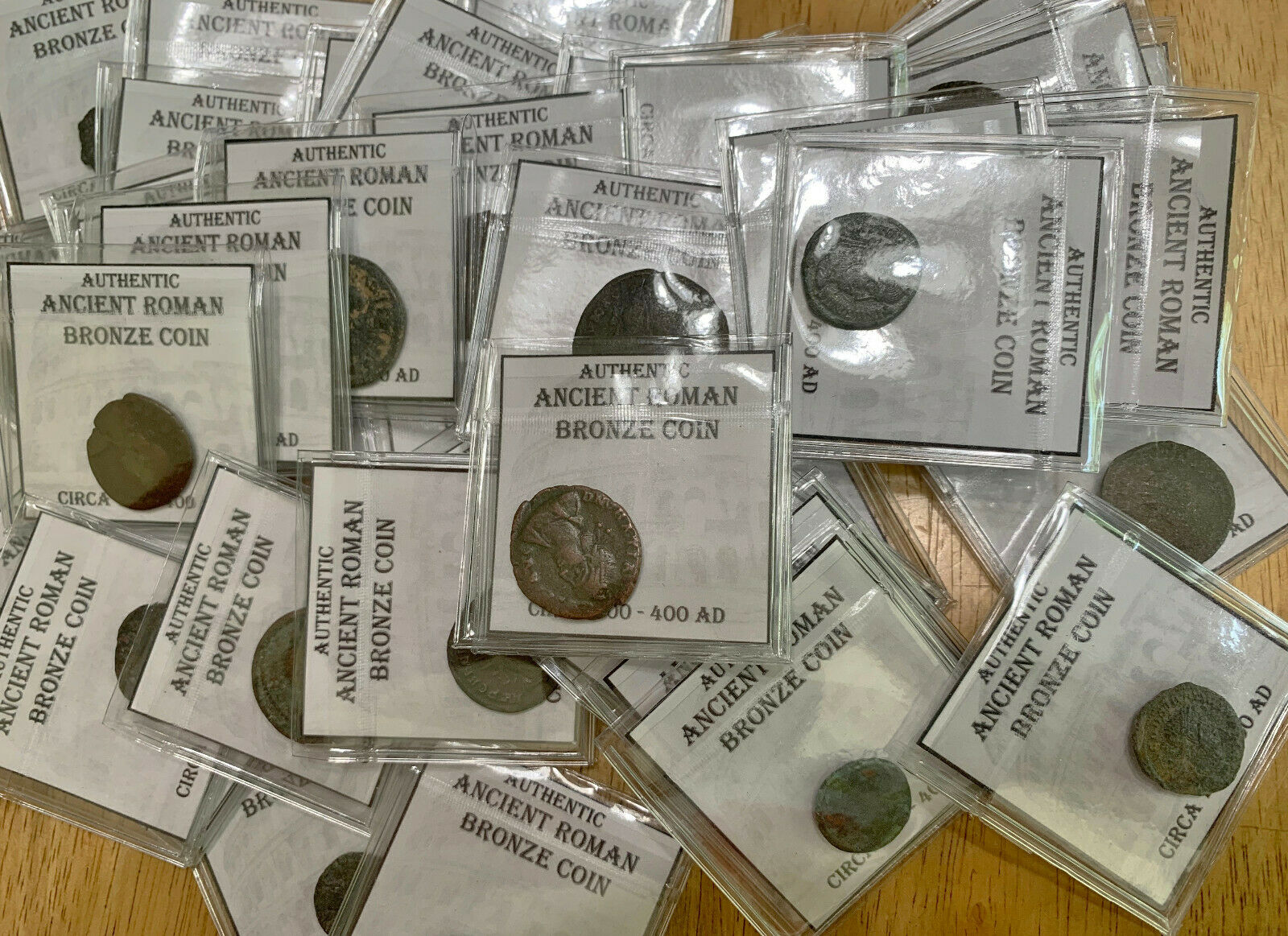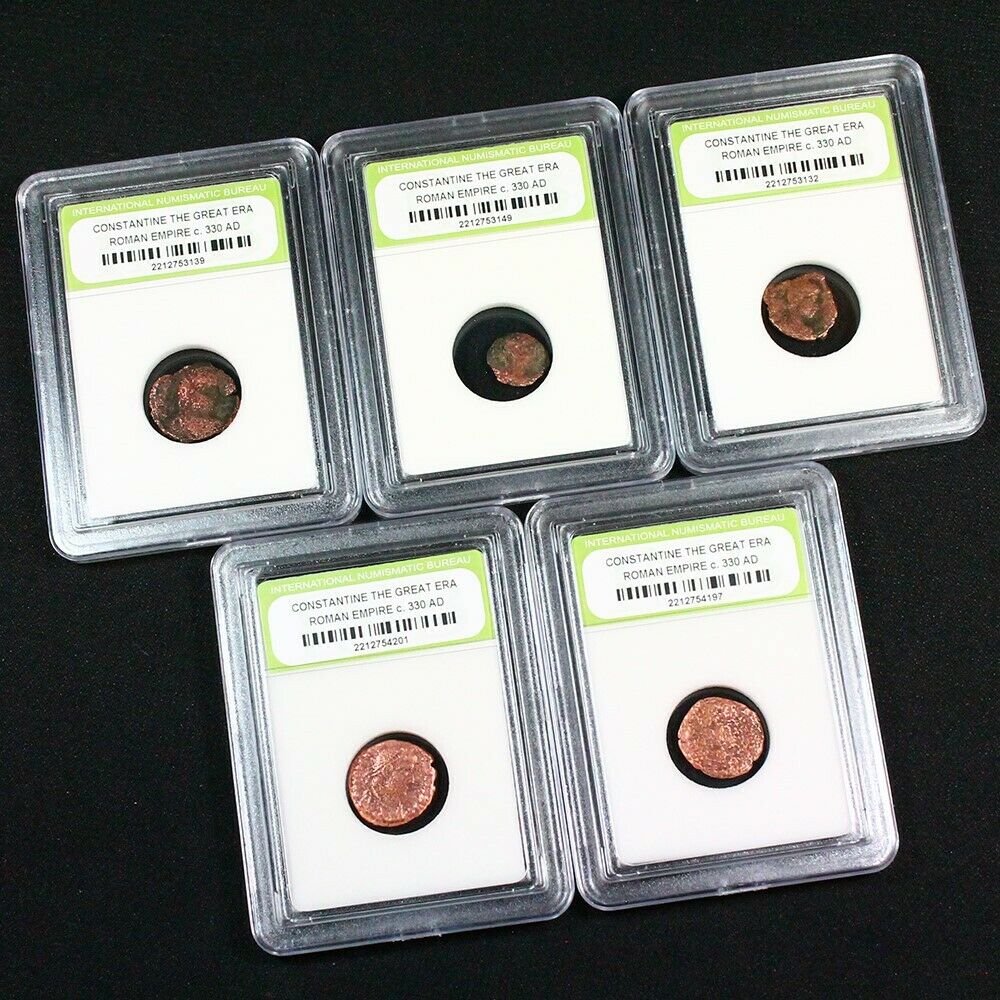-40%
Roman Empire Coin GALLIENUS Pax Holding Branch On Reverse Antoninianus
$ 20.59
- Description
- Size Guide
Description
ROMAN EMPIREAncient Coin
Antoninianus
Of
GALLIENUS
Roman Emperor 253-268 A.D.
Obv: GALLIENVS AVG
Radiate cuirassed bust of Emperor right
Rev: PAX AVG
Pax standing holding olive branch and sceptre
20.00 mm
PRIVATE
ANCIENT COINS COLLECTION
SOUTH FLORIDA ESTATE SALE
( Please, check out other ancient coins we have available for sale. We are offering 1000+ ancient coins collection)
ALL COINS ARE GENUINE
LIFETIME GUARANTEE
AND PROFESSIONALLY ATTRIBUTED
The attribution label is printed on archival museum quality paper
An interesting coin of Gallienus. Bust of Emperor Gallienus on obverse and Pax on reverse. This coin comes with free display case, easel and attribution label attached.
The attribution label is printed on archival museum quality paper.
A great way to display an ancient coins collection! You are welcome to ask any questions prior buying or bidding. We can ship it anywhere within continental U.S. for a flat rate of 6.90$. It includes shipping, delivery confirmation and packaging material.
Limited Time Offer:
FREE SHIPPING
(only within the continental U.S.)
The residents of HI/AK/U.S. Territories and International bidders/buyers must contact us for the shipping quote before bidding/buying
GALLIENUS
Publius Licinius Egnatius Gallienus was born in about AD 213.
This means that he was about 40 years old when his father Valerian, in AD 253, was hailed emperor by his troops in Raetia. Gallienus was made Caesar immediately by his father. But within a month, when Valerian got to Rome, Gallienus received the rank of Augustus.
Compared to other Roman emperors of the age, Gallienus was an exception, as far as he was not a soldier-emperor. He was rather a thoughtful, intellectual ruler, possessing sophisticated Greek tastes. However, this made him deeply unpopular with the gritty Danubian generals, who very much understood it as their right to choose a leader among their own ranks to rule the empire.
His father handed him responsibility over the western provinces, while he would take the fight east to the Persians. Though the two should never meet again, as Valerian fell into the hands of the enemy and died in captivity.
If the Danubian military elite didn't like Gallienus, then he certainly soon proved that he was a capable military leader. Between AD 254 to AD 256 he campaigned along the Danube, securing this troubled frontier against the barbarians. In AD 256 he then moved west to fight the Germans along the Rhine.
Seeking to continue the dynasty of his father, Gallienus raised his eldest son Licinius Valerianus to the rank of Caesar in early AD 256. But when in AD 258 the emperor returned to the Danube to renew his struggles with the barbarians there, his heir died. In his place, his brother Salonius was raised to be Caesar.
Then, in AD 259, the chaos began which was to haunt Gallienus throughout his reign. Gallienus was still fighting along the Danube, when message reached him that further west the Juthungi (Jutes) and the Alemanni had crossed the river a were descending into Italy.
In Italy a force was hastily assembled to stop their advance on the capital. Realising an advance only possible against stern opposition, the barbarians turned back and headed back for northern Italy, only to be met by Gallienus, who had marched his troops into Italy from the Danube. The barbarians suffered a crushing defeat at Mediolanum (Milan) and were later beaten again at Augsburg in spring of AD 260, with thousands of their Roman captives being freed.
But this success cannot disguise what was a desperate situation for Gallienus. The Franks were attacking in large numbers, crossing the Rhine and forcing their way into Gaul. Some even reaching as far as Tarraco (Tarragona) on the Mediterranean coast. Some even getting on boats, crossing the Mediterranean and raiding the north African coast, including the port of Tingitana.
The Sueves (Suevi) conquered the strategic land known as Agri Decumates, which covered the areas of the upper Rhine and Danube.
Weakened by such onslaughts, Gallienus could do little but accept the establishment of a realm by the Marcomanni, north of the Danube. A challenge earlier emperors would have never accepted. In order to come to peaceful terms with this new kingdom it is said that Gallienus even took a Marcomannic princess as a second wife.
Then by autumn AD 260 the dreadful message of Valerian's capture by the Persians reached Gallienus. If Gallienus had always been unpopular among the military leaders, then now with his father gone and Roman authority crumbling, rebellion was in the air.
The first to act was Ingenuus, the powerful governor of Pannonia. He had himself hailed emperor at Sirmium, by the troops of Pannonia and Moesia. Though these armies were merely the remaining garrison of the two provinces, as most were campaigning with the emperor. With such limited support Ingenuus was soon defeated at Mursa in Pannonia by the returning Gallienus and his general Manius Acilius Aureolus.
But the late Ingenuus' Danubian troops remained mutinous and soon after hailed Regalianus, the governor of Upper Pannonia, emperor. Within only a few weeks Gallienus returned once more and crushed the rebellion.
With Gallienus occupied with Regalianus, the command of the Rhine armies was left to Marcus Cassianius Latinius Postumus, governor of Lower Germany, with the emperor's son Saloninus, guarded by the praetorian prefect Silvanus, staying at Colonia Agrippina (Cologne).
But Postumus, confident after defeating a barbarian raid, fell out with Silvanus and marched on the city. In defiance, Saloninus was declared joint emperor with Gallienus, but it was an empty gesture. Shortly afterwards the garrison of Colonia Agrippina surrendered and the young emperor together with Silvanus were murdered.
Postumus was now proclaimed emperor, a significant group of western provinces of the empire siding with him. Meanwhile Gallienus, occupied with revolts and barbarians along the Danube, was not yet free to act against him.
But in late AD 260 yet another serious rebellion took place. Had the capture of emperor Valentinian left the defences of the east in utter turmoil. Antioch fell to the advancing Persians. Until two generals, Macrianus and Callistus (whose nickname was 'Ballista'), rallied what was left of Roman troops and defeated the Persian king Sapor at Corycus, halting his advance and forcing him to withdraw back behind the Euphrates. Of these two Roman generals Macrianus now decided the time was right to challenge Gallienus' rule. Though, knowing himself to old, he nominated not himself but his two sons, Fulvius Iunius Macrianus and his and Fulvius Iunius Quietus, as emperors of the east, with Antioch as their capital.
This rebellion won widespread recognition in Syria, Egypt and Asia Minor (Turkey).
But then they made a vital error, by marching against Gallienus. With Quietus staying behind to oversee government of their empire, his brother and father led their troops west to take power.
Gallienus however sent his general Domitianus against them and they were defeated and killed in the Balkans.
Gallienus found a rare ally in Odenathus, the very powerful prince of Palmyra, granting him command of the armies in the east. At once Odenathus attacked Quietus, the remaining rebel, at Emesa and defeated him.
The death of Quietus only saw yet another pretender to the throne arise, as Mussius Aemilianus, the governor of Egypt, who had supported Macrianus and Quietus, now had himself hailed emperor. But in AD 262 he, too, was defeated by general Theodotus and executed.
Also in AD 262, Odenathus launched a five year campaign against the Persians, re-conquering much of Mesopotamia and Armenia.
In the west Gallienus, having gained back at least some limited control over his territories, set out to crush Postumus in the spring of AD 265, advancing deep into Gaul.
Postumus, knowing his forces inferior, evaded his attacker, not granting him a pitched battle. And so, without being able to deal that all-important crushing blow, Gallienus couldn't defeat his elusive foe. And Gallienus' everlasting bad luck caught up with him again, when he was severly wounded in his back by an arrow while on this campaign. And so, with its supreme commander bed-ridden, the campaign had to be abandoned.
This left Postumus the undisputed ruler of the 'Gallic Empire'.
In the east, after outstanding victories against the Persians - most of all defeating the Persians at Ctesiphon in AD 266 -, Odenathus was awarded the title of imperator by Gallienus.
Following this, Odenathus set out for Asia Minor (Turkey) where he would drive out invading Goths. But alas, he was not to find much joy in his new found glory in his many victories, as he was murdered in AD 267.
As his eldest son, too, was killed his position fell to his widow Zenobia, who ruled through her son Vaballathus. With Odenathus' death Gallienus appeared to reach the decision that the time had come to put an end to the the power of Palmyra. Some doubtful rumours even suggested that he had been behind the plot which saw Odenathus killed.
The praetorian prefect Heraclius whom the emperor now sent out to crush Palmyra though was easily defeated. And Palmyra was still to play a leading role in the coming years of Roman history after Gallienus' death.
But Gallienus himself was to have far greater problems to deal with than either the Palmyrene queen Zenobia, or the 'Gallic' emperor Postumus.
In AD 268 a threat should emerge which should threaten to bring the entire empire crashing down. The greatest Gothic invasion so far came crashing into the Balkans. The seaborne Heruli supplied a fleet which carried vast armies down the coast of the Black Sea to land in Thracia and Macedonia. Other huge forces crossed the Danube in Moesia.
Seeking to save Athens Gallienus marched east. He couldn't prevent the sack of the ancient city, but nonetheless he came upon the main Gothic force at Naissus and defeated it at the gruesome battle of Naissus, the bloodiest battle of the third century, which left thirty to fifty thousand Goths dead on the field (AD 268).
Having perhaps saved the empire from oblivion, Gallienus could have dealt the Goths a shattering blow by hunting down and defeating their remaining forces.
But even at this brief moment of glory, Gallienus' should have to once more rush to challenge yet another pretender to his throne.
This time, his general Aureolus, who had been left at Mediolanum (Milan), to guard against any attack from Postumus, was the one to betray him.
The precise details of Postumus' betrayal seem unclear. He appeared to try and change sides Postumus 'Gallic Empire' in early AD 268. And yet, there was not even an attempt by Postumus to come to his aid, when Gallienus marched against him. More so, having withdrawn into Mediolanum, after suffering a defeat at Ponirolo, Aureolus pronounced himself emperor.
But Gallienus was not to gain victory over Aureolus. The Danubian military elite had finally had enough of the emperor they had never liked. A plot was hatched among the praetorian prefect Heraclianus and a group of high ranking commanders. Among these officers were the future emperors Claudius Gothicus and Aurelian.
And so on a night in September AD 268, at the siege of Mediolanum, the alarm was suddenly raised in the camp of the emperor. In the brief moment of confusion, Gallienus was struck down in the dark as he emerged from his tent.
As a last gesture of disrespect to this, most unfortunate of emperors, the Romans should lay Gallienus to rest not in one of the great mausoleums in Rome, but in a tomb nine miles south of the capital, along the Via Appia.
Alas, he was deified by the senate by request of Claudius II Gothicus, one of the men who had brought about his assassination.
SHIPPING INFO:
- The Shipping Charge is a flat rate and it includes postage, delivery confirmation, insurance up to the value (if specified), shipping box (from 0.99$ to 5.99$ depends on a size) and packaging material (bubble wrap, wrapping paper, foam if needed)
- We can ship this item to all continental states. Please, contact us for shipping charges to Hawaii and Alaska.
- We can make special delivery arrangements to Canada, Australia and Western Europe.
- USPS (United States Postal Service) is the courier used for ALL shipping.
- Delivery confirmation is included in all U.S. shipping charges. (No Exceptions)
CONTACT/PAYMENT INFO:
- We will reply to questions & comments as quickly as we possibly can, usually within a day.
- Please ask any questions prior to placing bids.
- Acceptable form of payment is PayPal
REFUND INFO:
- All items we list are guaranteed authentic or your money back.
- Please note that slight variations in color are to be expected due to camera, computer screen and color
pixels and is not a qualification for refund.
- Shipping fees are not refunded.
FEEDBACK INFO:
- Feedback is a critical issue to both buyers and sellers on eBay.
- If you have a problem with your item please refrain from leaving negative or neutral feedback until you have made contact and given a fair chance to rectify the situation.
- As always, every effort is made to ensure that your shopping experience meets or exceeds your expectations.
- Feedback is an important aspect of eBay. Your positive feedback is greatly appreciated!
<div style="text-align:center"><a style="text-decoration:none" href="https://mostpopular.sellathon.com/?id=AC1019108"><img src="https://www.sellathon.com/Resources/Images/countercredit.gif" border="0"></a></div>












